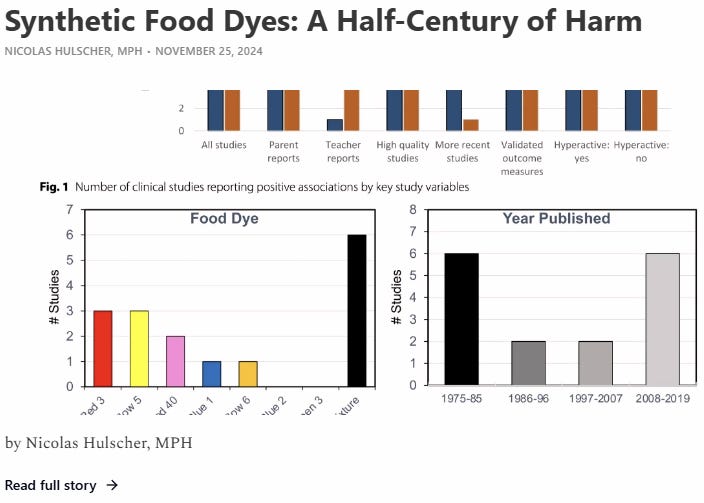FDA to Remove Toxic Artificial Food Dyes from U.S. Food Supply and Medications
Long-overdue plan is a critical first step toward reversing a half-century of harm.
This article originally appeared on Focal Points and was republished with permission.
Guest post by Nicolas Hulscher, MPH
In a landmark move aimed at addressing the chronic disease epidemic, FDA Commissioner Dr. Marty Makary announced yesterday that the agency will eliminate petroleum-based synthetic food dyes from the American food and drug supply.
“For the last 50 years, American children have increasingly been living in a toxic soup of synthetic chemicals,” said Makary, highlighting growing scientific evidence linking artificial dyes to conditions like ADHD, obesity, diabetes, insulin resistance, cancer, allergic reactions, and genomic damage.
Makary cited a double-blind, placebo-controlled Lancet study by McCann et al that found artificial colors lead to increased hyperactivity in children:
The trial included 153 children aged 3 and 144 aged 8–9, who consumed drinks with or without common food dyes and sodium benzoate. Mix A and Mix B contained combinations of widely used synthetic dyes—including sunset yellow, tartrazine, carmoisine, and allura red—plus the preservative sodium benzoate, in doses typical of a few small bags of sweets. Among 3-year-olds with high compliance, Mix A significantly raised hyperactivity levels (effect size 0.32, p = 0.02). In 8/9-year-olds, both Mix A and Mix B led to higher hyperactivity scores, with Mix B showing a strong effect (0.17, p = 0.001). The results confirm behavioral impacts from these additives in the general child population.
The Plan to Eliminate Harmful Dyes
Establish a national standard and timeline to guide food manufacturers in transitioning from synthetic dyes to natural alternatives.
Revoke authorization for non-producing synthetic colorings such as Citrus Red No. 2 and Orange B within the coming weeks.
Eliminate six remaining dyes currently in use:
Red Dye No. 40
Yellow Dye No. 5
Yellow Dye No. 6
Blue Dye No. 1
Blue Dye No. 2
Green Dye No. 3
Target removal date: By the end of next year (2026).
Makary noted that 30 states have already introduced or passed legislation targeting these dyes, creating a confusing patchwork for food companies. The FDA’s move seeks to standardize policy and give the industry clear direction.
This long-overdue plan is a critical first step toward reversing a half-century of harm:
Epidemiologist and Foundation Administrator, McCullough Foundation
www.mcculloughfnd.org
Please consider following both the McCullough Foundation and my personal account on X (formerly Twitter) for further content.
Copyright 2025 Focal Points






